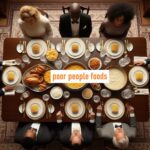Key Takeaways:
- Perfect Lighting: Learn how to use natural and artificial light for mouth-watering food photos.
- Enhance Details: Discover how different lighting setups can highlight textures and colors.
- Easy Tips: Get simple, actionable advice to instantly improve your food photography.
When it comes to food photography, lighting can make or break your shot. Whether you’re snapping pictures for a blog, social media, or just to share with friends, mastering lighting techniques is key to making your food look as delicious as it tastes. Let’s explore how you can use lighting to elevate your food photography and make those dishes shine.
1. Understanding Lighting Basics
1.1 Natural vs. Artificial Light
Natural Light:
- What It Is: Light coming from the sun, whether direct or diffused through windows.
- Why It’s Great: Natural light is often softer and more flattering, making food look fresh and appealing.
Artificial Light:
- What It Is: Light sources like lamps, flashes, or LED lights.
- Why It’s Great: Artificial light allows for more control, especially in low-light conditions.
1.2 The Importance of Light Direction
Front Lighting:
- Effect: Illuminates the food directly, reducing shadows but sometimes flattening textures.
- Use For: Simple, clean shots where detail and color are important.
Side Lighting:
- Effect: Creates shadows and highlights that enhance texture and depth.
- Use For: Showcasing intricate details and creating a more dramatic effect.
Backlighting:
- Effect: Light comes from behind the food, creating a glowing effect and highlighting transparency.
- Use For: Highlighting the texture and translucency of foods like fruit or glassy sauces.
2. Natural Lighting Techniques
2.1 Using Window Light
Why It’s Effective: Window light is soft and diffused, which is ideal for food photography.
How to Do It:
- Find a Window: Position your setup near a window with natural daylight.
- Diffuse the Light: Use a sheer curtain or a white sheet to soften direct sunlight.
- Adjust the Angle: Experiment with the angle of the light to see what flatters your food best.
Pro Tip: Avoid harsh midday sun, as it can create strong shadows and unappealing glare.
2.2 Reflectors and Diffusers
Reflectors:
- Purpose: Bounce light back onto your food to fill in shadows.
- How to Use: Place a reflector opposite your light source.
Diffusers:
- Purpose: Soften harsh light to create an even, flattering illumination.
- How to Use: Place a diffuser between your light source and the food.
Pro Tip: You can make DIY reflectors and diffusers using household items like white foam board or a shower curtain.
3. Artificial Lighting Techniques
3.1 Using Softboxes
What They Are: Softboxes are light modifiers that diffuse light to create a soft, even illumination.
How to Use:
- Set Up: Position the softbox to the side or above your food.
- Adjust Intensity: Control the light intensity to avoid overexposing your food.
Pro Tip: Softboxes are great for simulating natural light and reducing harsh shadows.
3.2 LED Lights and Light Tents
LED Lights:
- Purpose: Provide consistent and adjustable lighting.
- How to Use: Position LED lights at various angles to control shadows and highlights.
Light Tents:
- Purpose: Enclose your food in a tent with diffused light on all sides.
- How to Use: Place your food inside the tent and light from outside.
Pro Tip: Light tents are excellent for creating a uniform lighting effect and reducing reflections.
4. Tips for Enhancing Food Photography with Lighting
4.1 Avoid Direct Flash
Why: Direct flash can create harsh shadows and unappealing reflections on glossy surfaces.
Alternative: Use indirect lighting or bounce flash off a ceiling or wall.
4.2 Experiment with Light and Shadows
Why: Playing with shadows can add depth and texture to your food photos.
How to Experiment: Adjust the light source angle and intensity to see how it changes the look of your food.
4.3 Maintain Consistent Color Temperature
Why: Mixing light sources (like natural and artificial light) can result in color mismatches.
How to Maintain Consistency: Stick to one type of light source or use color-correcting filters.
4.4 Use Props and Backgrounds
Why: Props and backgrounds can enhance the overall composition of your food photos.
How to Use:
- Choose Neutral Backgrounds: A plain or subtly textured background helps keep the focus on the food.
- Add Complementary Props: Use items like napkins or utensils that match the style of your dish.
5. Practical Examples
5.1 Rustic Bread Photography
Lighting Setup: Use soft, natural window light from the side to highlight the bread’s texture.
Tip: Place a reflector opposite the window to fill in shadows and enhance the crust’s detail.
5.2 Smoothie Bowl Photography
Lighting Setup: Use backlighting to emphasize the freshness and vibrant colors of the smoothie.
Tip: Position the light source behind the bowl and use a diffuser to soften the light for a glowing effect.
5.3 Steak Photography
Lighting Setup: Side lighting works best to capture the juicy details and caramelization of the steak.
Tip: Use a light tent to control reflections and create a balanced look.
6. Conclusion
Lighting is a crucial element in food photography that can dramatically influence how your dishes are perceived. By understanding and applying various lighting techniques, you can turn ordinary food into extraordinary visual experiences. Whether you’re using natural sunlight, artificial lights, or a combination of both, the key is to experiment and find what works best for your particular setup. With these tips and techniques, you’ll be able to capture stunning food photos that make your culinary creations look as delicious as they taste. Happy shooting!









